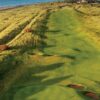
Dean Bailey visits Teesside to take in the history of Wilton Golf Club and tackle a relatively short, yet incredibly tricky, golf course
T eesside is blessed with great golf courses within just a few miles of one another. From coastal links and modern championship tests to parkland courses hidden close to the industrial heartbeat of region, there’s a lot on offer.
Wilton Golf Club falls perfectly into the latter category. Formed in 1952 as part of ICI Wilton’s Recreation Club to play matches locally, the club’s nine-hole course opened in 1956. By 1963, membership was more than 600, and a year later the course was extended to 18 holes. With the opening of a clubhouse in May 1967, popularity continued to rise and membership grew to more than 1,000 in 1974.
A new clubhouse followed in 1979 and in 1999 the club was purchased by its members – who continue to develop and enjoy it.
The course, which measures 6,220 yards from the white tees, opens with a series of relatively newer holes. The sub-300-yard first plays uphill to a green which is considerably wider than it is deep. Long hitters should aim right to leave the best angle in while avoiding the out of bounds fence to the left – and all players must stay out of the three bunkers which guard the front edge and sit well below the putting surface.
A pair of par fours – 360 and 328 yards respectively – played at the foot of the Eston Hills follow. Both fairways slope from left to right, with players required to drive close to the out of bounds fence on the left in order to hold the short grass. At the second, the approach is uphill to a small green featuring three grass bunkers. At the third, a large bunker protects the front right of the green, particularly against those who have bailed out to the right with their tee shot.
The first of two steeply downhill par threes on the front nine, the fourth plays considerably shorter than its 204 yards. Short is always best here, with firm bounces carrying the ball between the two front bunkers with a little luck. The green is 40 yards long, and anything left will bounce towards the boundary fence with little to stop it.
The longest hole on the course, the 519-yard fifth is often downwind and is always a good birdie chance. Two bunkers guard the inside corner of the right-to-left dogleg from overly aggressive tee shots while approaches must favour the right side to avoid a cross bunker and get a helpful bounce to the left onto a small green which is guarded by a single deep bunker on its left side and multiple runoff areas.
A birdie on five often comes in handy as you turn back into the wind to tackle the 441-yard par four sixth. Favour the left side from the tee to use the slope and stay clear of the bunker on the right. From here, the hole turns slightly right to a green which is cut into the slope and can be tough to hold, particularly when playing into a narrower target from the left side of the fairway.
The 140-yard seventh hole also plays much shorter than its yardage. The slopes around the green are steep, particularly at the front, and a shot which lands in the heart of the green always leaves a good look at birdie.
The small, elevated green at the par four eighth can be hard to find, particularly if you stray into the trees or the fairway bunker on the right side of this right-to-left dogleg. A bunker left and tree overhanging the right of this incredibly narrow green make for a tough approach.
Crossing onto the older half of the course, the 403-yard ninth is one of the trickiest driving holes. With out of bounds left and the tee pointing straight at the fence, a left to right shape is required to find this rig and furrow fairway. The boundary is tight en-route to the green too, where you’ll find a bunker with a tall front edge on the left side – though there is room out to the right.
A 157-yard par three follows, with a narrow entrance to the green guarded by a pair of bunkers. The green is more generous than it may appear.
The signature hole follows.
The 395-yard 11th is a demanding par four with risk at every turn. The fairway turns 90 degrees from right to left, with a tee shot of at least 240 yards required to reach the corner – Sheila’s Tree just right of centre is a good line. A pond guards the right side at around 200 yards, while dense trees guard the left side. The green, which sits above the fairway, is protected by a pair of large bunkers at its sides and slopes significantly from back to front
Two more tricky holes follow in Wilton’s back nine stretch of potential card-wreckers.
At the 452-yard 12th, a well-positioned tee shot is key as a ditch runs diagonally across the fairway from left to right. Left of the oak tree is the tighter line, while longer hitters can go over the tree to the right side and minimise the risk of running into the ditch. The elevated green is more receptive to shots from the left, though its only bunker will gather anything a little too short and left.
A short par five of 493 yards, the 13th can be tricky. Tee shots with driver from the back tee must move left-to-right to find the fairway between the trees while avoiding the out of bounds left. From here, the hole turns again, this time right to left around ancient trees and a large bunker 90 yards from the green. The hole then rises steeply to a plateau green set in front of Wilton Castle.
A 400-yard par four with out of bounds left follows. The fairway bunker is 230 yards from the tee and can catch players out, particularly when playing into the wind. The right side is safer, though you’re then faced with a tiny target for your second shot with out of bounds just a few paces beyond the green on the left and a steep drop on the right side which leaves a perilous pitch up to a putting surface which slopes from back to front.
If the 14th fairway is generous, the 15th is anything but. Having found it, you’re faced with the best-defended green at Wilton with bunkers short left, middle left and back right.
The final par three, the 158-yard 16th is played to another small target with a large tree and grass bunker left while a trio of bunkers guard the right side.
At the 17th, aim for the right half of the narrow fairway to leave the best angle to a two-tier green which is wrapped around the left bunker and slopes steeply from back left to the right side – where a second bunker awaits.
Tee shots at the 390-yard par four 18th must navigate around an oak tree in the centre of the fairway – which can be difficult given its size. Play left for a better angle to a tiny elevated green with a bunker on its left side which has a huge catchment area, including the left side of the green itself. There is however plenty of room out to the right.
Caddy’s tip
This is very much a second shot golf course – the greens are small and well-guarded by bunkers, false fronts and many slopes. Good wedge players will score well here
Our verdict
A wonderful club to spend time at, in the clubhouse and on the course, a visit to Wilton this summer is highly recommended








